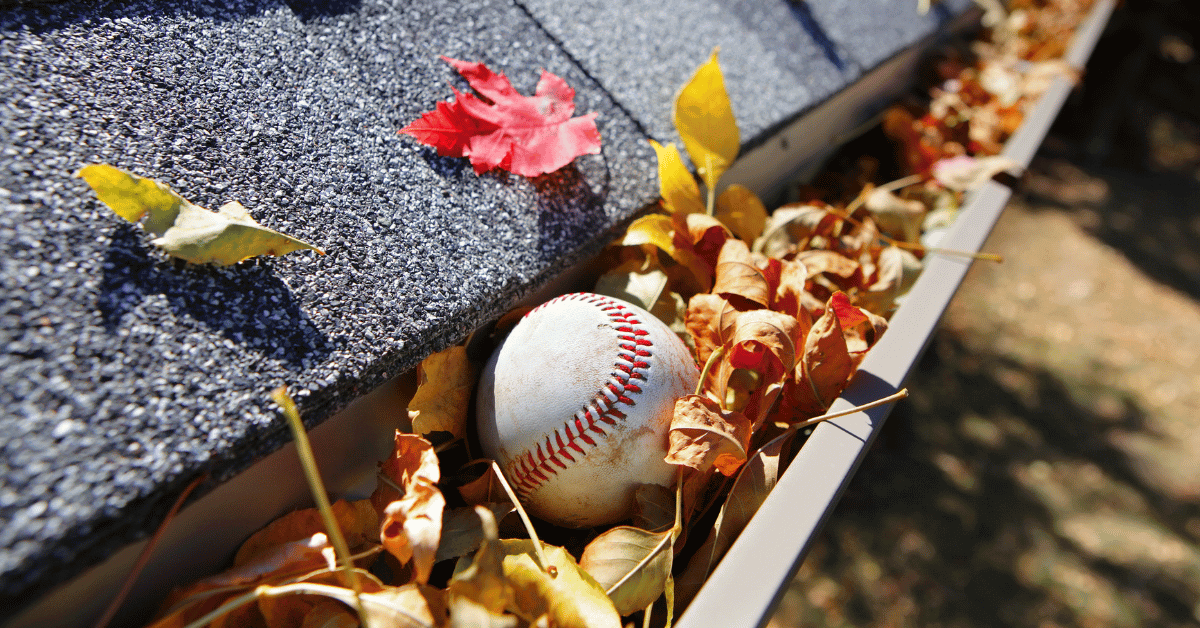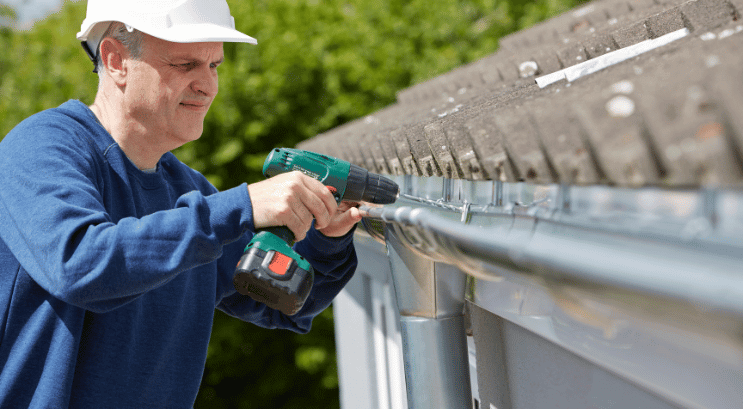Introduction
If you’re seeking information on how to install gutter guards, you likely understand the importance of preventing clogged and overflowing gutters. Gutter maintenance is a task often overlooked by homeowners until they face the daunting aftermath of clogged, overflowing gutters during a heavy rainstorm. The accumulation of leaves, twigs, and debris can lead to water damage on your home’s exterior and foundation, costly repairs, and a plethora of other issues. If you find yourself frequently on a ladder clearing out gutters, or if you reside in an area prone to significant weather events that expedite gutter clogging, it’s time to consider a permanent solution: gutter guards. This comprehensive guide is designed not only to introduce you to the world of gutter guards but also to navigate you through the DIY gutter guards installation process. Whether you’re an experienced DIY enthusiast or considering whether to tackle the installation yourself or hire a professional, this article has got you covered.
Compare Top Professional Installers
If you feel that taking on the task yourself might be too challenging or time-consuming, you should consider hiring a professional company for gutter guard installation. We conducted a comprehensive review methodology for reputable experts who can efficiently handle the installation for you, ensuring that your gutter guards are installed correctly and effectively, ultimately protecting your home from potential damage. We recommend gathering quotes from at least three different companies when considering a gutter guard installation provider. It’s a convenient option for those who prefer to leave this important home maintenance task in the hands of experienced professionals. And the best part is that you can get free, no-commitment quotes from companies near you.
| Company | Logo | Star rating | Link |
| Nationwide Gutters |  |
4.9 ⭐⭐⭐⭐⭐ | Visit website |
| Leaffilter | 4.6 ⭐⭐⭐⭐⭐ | Visit website | |
| Leafguard |  |
4.3 ⭐⭐⭐⭐ | Visit website |
| Modernize |  |
4.2 ⭐⭐⭐⭐ | Visit website |
| Gutter Guards America |  |
4.1 ⭐⭐⭐⭐ | Visit website |
Can You Install Your Own Gutter Guards?
The short answer is, yes. Installing gutter guards is a project that many homeowners can undertake with success. The key to a successful DIY gutter guard installation lies in proper planning, having the right tools at your disposal, and choosing the right type of gutter guard for your home. While some homeowners may be comfortable with heights and handy with tools, others might find the prospect daunting. It’s important to assess your own skills and limitations before deciding to proceed. Installing gutter guards on your own can save you a significant amount of money in professional installation fees and provide you with a sense of accomplishment. However, it’s crucial to approach this task with safety in mind and to ensure you’re not biting off more than you can chew. For a detailed understanding of potential expenses, consider exploring the different costs of gutter guard installation to prepare adequately for the project.
Do All Gutter Guards Go Under Shingles?
A common question among homeowners is whether all gutter guards need to be installed under the shingles of their roof. The answer varies based on the type of gutter guard you choose. Not all gutter guards are designed to go under shingles; some are meant to be attached directly to the gutter’s edge or fit snugly inside the gutter without disturbing the roofline. Installing gutter guards under shingles can offer additional stability against heavy winds and rain but may not be advisable or necessary for all types of guards or roofs. It’s essential to consult the installation instructions provided with your gutter guards and, if in doubt, seek professional advice to avoid potential damage to your roof.
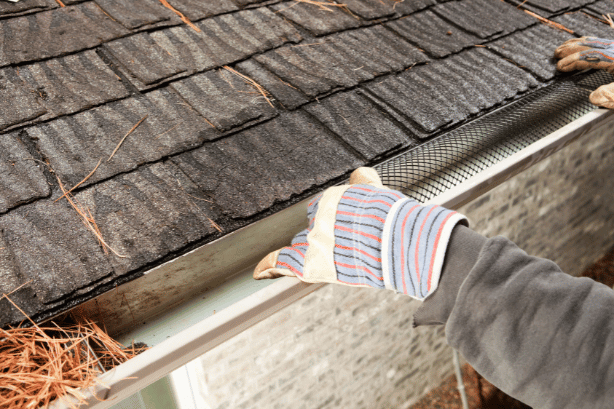
Before You Begin
Starting the process of installing gutter guards to safeguard your house from the woes of clogged gutters is a commendable DIY project. However, it’s crucial to approach this task with the right preparation and mindset. While crafting gutter guards from scratch is not advisable due to the precision required in design and materials, a wide array of commercial gutter guards are available to meet every homeowner’s needs. Having the correct tools and safety gear on hand is non-negotiable, as is ensuring you’re comfortable working at heights.
Essential Tips for Installing Gutter Guards
- Preparation is Key: Ensure your gutters are free from debris and in good repair before attempting to install gutter guards. A clean base is essential for a successful installation.
- Selecting the Suitable Guards: Not all gutter guards are created equal. Evaluate your home’s specific needs—considering factors like the surrounding environment and the type of debris commonly encountered—to select the most effective type of gutter guard.
- Follow the Instructions: Whether you opt to undertake the installation yourself or decide to go with a professional, adhering to the manufacturer’s installation guidelines is crucial for the gutter guards to function correctly.
Safety First
- Equipped for Safety: Attach a bucket to your ladder with an S-hook for convenient access to your tools and materials, minimizing the need for frequent climbs up and down.
- Stable Ladder Usage: Opt for a sturdy, stand-alone ladder rather than leaning it against your gutters, which could cause damage or instability. Make sure the ladder is on solid, level ground to prevent accidents.
- Buddy System: It’s wise to have a friend or family member present to hold the ladder steady, pass tools, or provide assistance in case of an emergency. This support can significantly enhance safety and efficiency.
By starting your gutter guard installation project with these considerations in mind, you can ensure a smoother process and safer working conditions. Remember, taking your time to prepare and following these guidelines can make the difference between a job well done and a missed opportunity for effective home maintenance.
Step 1: Evaluate Your Ability and Gather Tools
| Tools needed | |
|---|---|
| Ladder | S-hook |
| Screwdriver | Tape measure |
| Hammer | Handsaw or circular saw |
| Bucket | Gutter guards |
It’s advisable to gather all necessary tools and supplies beforehand, ensuring easy access during the project. You can conveniently place the screwdriver and hammer in a bucket, hanging it securely on an S-hook attached to the ladder for quick retrieval.
Gutters are commonly measured in linear feet. To determine the length of gutter guards needed for your specific gutter system, you should utilize a tape measure to ascertain the length of your gutters. This measurement serves as a crucial factor in determining the accurate amount of gutter guards to purchase.
Following the manufacturer’s guidelines is crucial when it comes to cutting and installing gutter guards. Properly cutting the guards may require the use of a circular saw or handsaw.
During the installation phase, it’s imperative to securely fasten each guard piece. In the event of a storm, if the gutter guard isn’t properly secured, it may fail to perform its intended function, potentially resulting in water damage.
DIY Gutter Guards: Assessing Your Skills
Before diving into the project, it’s critical to honestly evaluate your DIY skills, comfort level with working on a ladder, and familiarity with the tools required for the job. Gutter guard installation involves heights, precision and cutting materials to fit specific lengths. If you’re not comfortable with these aspects or lack the necessary tools, it might be more prudent to hire professionals. On the contrary, if you’re skilled at home improvement projects and have a good head for heights, installing gutter guards could be a rewarding weekend project. Ensure you have all the necessary tools and materials listed in the previous section before starting.
Step 2: Selecting the Right Gutter Guard
The best gutter guards for your home are determined by several factors, including the material’s durability and the homeowner’s budget. There are a number of different gutter guard types, with each having their own pros and cons.
| Type | Description | Pros | Cons |
|---|---|---|---|
| Screen Guards | These guards have large holes and are laid on top of the gutters. | Easy to install, affordable. | Require regular cleaning, less durable. |
| Mesh Guards | Fine mesh covers that fit over gutters, blocking most debris. | Effective debris blockage, durable. | More expensive, may need professional install. |
| Foam Guards | Foam inserts that fit directly into gutters, allowing water through but blocking debris. | Simple installation, effective filtration. | Shorter lifespan, can trap small debris. |
| Surface Tension Guards | Curved guards that use surface tension to draw water into the gutter while shedding debris. | Low maintenance, effective in heavy rain. | Expensive, require precise installation. |
| Brush Guards | Brushes that sit inside the gutter, letting water flow through while catching debris. | Easy to install, good for large debris. | Not effective for small particles, regular cleaning. |
| Micro-Mesh Guards | Extremely fine mesh guards offering superior filtration. | Excellent debris blockage, durable. | Higher cost, may need professional installation. |
| Foam Filters | Porous foam pieces that fit in gutters, similar to foam guards, but designed for better water flow. | Easy to install, affordable. | Can degrade over time, require replacement. |
How to Install Gutter Guards That Fit Your Home
The market is flooded with various types of gutter guards, each promising to be the best solution to your gutter woes. From easy-on gutter guard installation options like foam and brush guards to more permanent solutions like micro-mesh or surface tension systems, the choices can be overwhelming. Consider factors such as the types of debris common in your area, the average rainfall, and your budget when selecting a gutter guard. Each type has its pros and cons, and what works best for one home may not be the ideal solution for another. Take the time to research and possibly consult with professionals or fellow homeowners to make a sophisticated decision.
Step 3: Preparing Your Gutters
A clean gutter is the foundation of a successful gutter guard installation. Begin by removing all debris, leaves, and sediment from your gutters. This might require a hand scoop, gloves, and a hose to flush out the downspouts. Ensuring your gutters are completely clean before installation cannot be overstated; failure to do so can lead to water backup and even damage to the gutter guards themselves. This is also an excellent opportunity to inspect your gutters for any signs of damage or wear and make necessary repairs. A well-maintained gutter system is crucial for the effectiveness of your gutter guards.

Step 4: Testing Your Gutters for Debris
To guarantee that the gutters are clear of debris and prepared for the installation of guards, conducting a water test with a hose is recommended. During this process, you should activate the water supply and position the hose in the gutters to observe the flow of water through them. Should the water move sluggishly and fail to exit through the downspout, it indicates the presence of leaves or debris in the gutters. Conversely, if the water flows smoothly and exits the downspout, the gutters are ready for the installation of gutter guards.
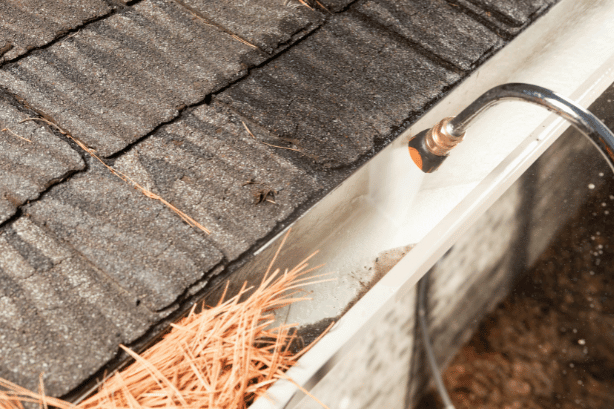
Step 5: Installing Your Gutter Guards
Once your gutters are prepared, it’s time to install the gutter guards. The installation method will depend on the type of guards you’ve chosen. Some guards may simply clip onto the edge of the gutter, while others might require more secure fastening methods like screws or nails. Gutter screen installation, for example, often involves clipping or snapping the screens into place, making them a popular choice for DIY enthusiasts due to their straightforward installation process. On the other hand, installing leaf guards or more complex systems like micro-mesh guards might require additional steps, like cutting the guards to fit your gutter length with a handsaw or circular saw, and then securing them with screws to ensure they stay in place even during severe weather.
Regardless of the type, it’s crucial to follow the manufacturer’s instructions to the letter. These instructions are designed not only to guide you through the installation process but also to ensure the gutter guards function as intended. Pay special attention to how the guards are supposed to fit onto or into your gutters, as improper installation can lead to gaps where debris can enter or cause the guards to be less effective.
Installing Gutter Guards Under Shingles
For those types of guards that require sliding under the shingles, proceed with caution. This method can offer additional stability, but it’s important not to compromise your roof’s integrity. Lift the shingles gently and slide the guard’s edge underneath. Ensure you’re not breaking the seal of the shingle to the roof, as this can lead to water ingress and potential damage. If you’re unsure, this might be a step where consulting with a professional could save you from expensive repairs down the line.
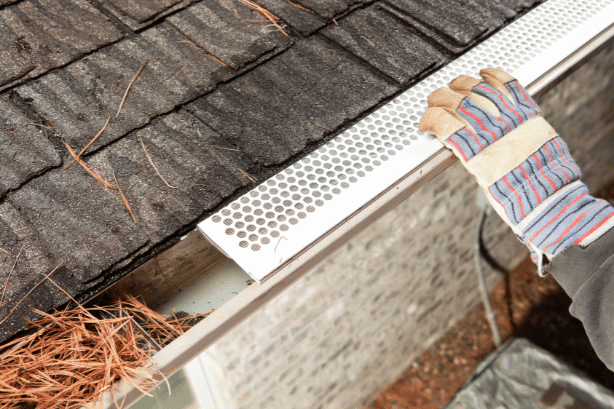
Step 6: Maintenance and Troubleshooting
Keeping your gutter guards in optimal condition is essential for ensuring they perform effectively in the long run. Regular maintenance is key to their longevity and continued functionality.

Common Problems About Gutter Guards
Even with gutter guards installed, no system is entirely maintenance-free. Over time, you may encounter issues such as small debris accumulation on top of the guards, which can impede water flow if not regularly cleaned. Some gutter guards, especially the foam type, can become a breeding ground for seeds and saplings, so it’s important to inspect and clean your gutter guards periodically. It is important to stay informed and up to date on upkeep expenses by educating yourself on gutter cleaning costs to manage your gutter maintenance effectively.
Another common issue is the guard detaching from the gutter due to improper installation or severe weather. Regular checks, especially after storms, can help ensure your gutter guards remain securely in place. Adjustments and minor repairs can often be done without professional help, but for significant issues, don’t hesitate to call in the experts.
Conclusion: Is It Better to Have Gutter Guards or Not?
The decision to install gutter guards boils down to weighing their benefits against the cost and potential for issues. For many homeowners, the appeal of significantly reduced gutter maintenance and the protection gutter guards offer against water damage make them a worthwhile investment. While no gutter guard system can promise to be entirely maintenance-free, the right setup can minimize the need for gutter cleaning and prolong the lifespan of your gutter system.
Ultimately, the effectiveness of gutter guards will depend on choosing the right type for your home, proper installation, and regular maintenance. By taking the time to research and possibly invest in professional installation for more complex systems, you can ensure that your gutters remain protected for years to come.
Get free installation quotes from professionals in just minutes
Most Popular
- Stainless Steel Micromesh
- Transferable lifetime warranty
- 120,000+ Trustpilot Reviews
Our top pick

- Quickest estimates
- Database of hundreds of professional contractors
- Affordable yet highly professional
Great choice

- Pairs you with up to four pre-vetted pros from their network.
- Free cost calculator
- 24/7 support
FAQs
Let’s address some additional common questions about gutter guards to ensure you have all the information you need to make an informed decision. By considering these factors and planning accordingly, you can ensure a successful gutter guard installation, whether you choose to DIY or hire a professional.
Can I install gutter guards myself?
Yes, numerous types of gutter guards are designed for easy DIY installation. However, assess your comfort with the required tools and heights before beginning.
How hard is it to install gutter guards?
The difficulty varies based on the type of gutter guard and your DIY experience. Brush and foam guards are generally easier to install, while micro-mesh and surface tension systems might require more advanced skills and tools.
How are gutter guards attached?
Attachment methods vary from snapping or clipping onto the gutter edge to sliding under shingles or screwing directly into the gutter.
Should gutter guards lay flat?
Ideally, gutter guards should match the pitch of your roof to prevent debris accumulation on top, facilitating natural debris clearance by wind and rain.
What is the easiest gutter guard to install?
Brush and foam gutter guards are among the easiest to install due to their simple design and minimal need for tools.
Do I need to clean gutters if I have gutter guards?
While gutter guards significantly reduce the need for cleaning, occasional maintenance to remove small debris and inspect the system is still recommended.

